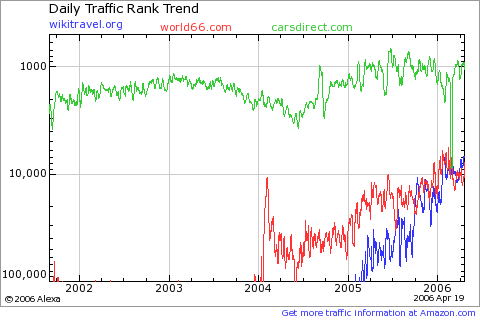A few things I heard about at CodeCon outside the presentations.
Vesta was presented at CodeCon 2004, the only one I’ve missed. It is an integrated revision control and build system that guarantees build repeatability, in part by ensuring that every file used by the build is under revision control. I can barely keep my head around the few revision control and build systems I occasionally use, but I imagine that if I were starting (or saving) some large mission-critical project that found everyday tools inadequare it would be well worth considering Vesta. About its commercial equivalents, I’ve mostly heard second hand complaining.
Allmydata is where Zooko now works. The currently Windows-only service allows data backup to “grid storage” presumably a distributed file store as used by MojoNation. Dedicate 10Gb of local storage to the service, you can back up 1Gb, free. Soon you’ll be able to pay for better ratios, including $30/month for 1Tb of space. I badly want this service. Please make it available, and for Linux! Distributed backup has of course been a dream P2P application forever. Last time I remember the idea getting attention was a Cringely column in 2004.
Some people were debating whether the Petname Tool does anything different from what SPKI/SDSI specify and whether either would make phishing substantially harder. The former is debated in comments on Bruce Schneier’s recent post on petnames, inconclusively AFAICT. The Petname Tool works well and simply for what it does (Firefox only), which is to allow a user to assign a name to a https site if it is using strong encryption. If the user visits the site again and it is using the same certificate, the user will see the assigned name in a green box. Any other site, including one that merely looks like the original (in content or URL), or even has hijacked DNS, appears to be “secure” but uses a different certificate, will appear as “untrusted” in a yellow box. That’s great as far as it goes (see phollow the phlopping phish for a good description of the attack this would save reasonable user from), though the naming seems the least important part — a checkbox to begin trusting a site would be nearly as good. I wonder though how many users have any idea that some pages are secure and others are not. The petname tool doesn’t do anything for non-https pages, so the user becomes inured to seeing it doing nothing, then does not see it. Perhaps it should be invisible when not on a secure site. Indicators like PageRank, Alexa rank (via the Google and Alexa toolbars) and similar, SiteAdvisor, and whether the visitor has previously visited the site in question before would all help warn the user that any site may not be what they expect — nearly everyone, including me, confers a huge amount of trust on non-https sites, even if I never engage in a financial transaction on such a site. I imagine a four-part security indicator in a prominent place in the browser, with readings of site popularity (rank), danger as measured by the likes of SiteAdvisor, the user’s relationship with the site (petname) and whether the connection is strongly encrypted.
Someone claimed that three letter agencies want to mandate geolocation for every net access device. No doubt some agency types dream of this. Anyway, the person said we should be ready to fight this if it were to become a real push for such a law, because what would happen to anonymity? No doubt such a mandate should be fought tooth and nail, but preserving anonymity seems like exactly the wrong battle cry. How about privacy, or even mere freedom? On that note, someone briefly showed a tiny gumstix computer attached to and powered by what could only be called a solar flap. This could be slapped on the side of a bus and would connect to wifi networks whenever possible and route as much Mixmaster traffic as possible.


